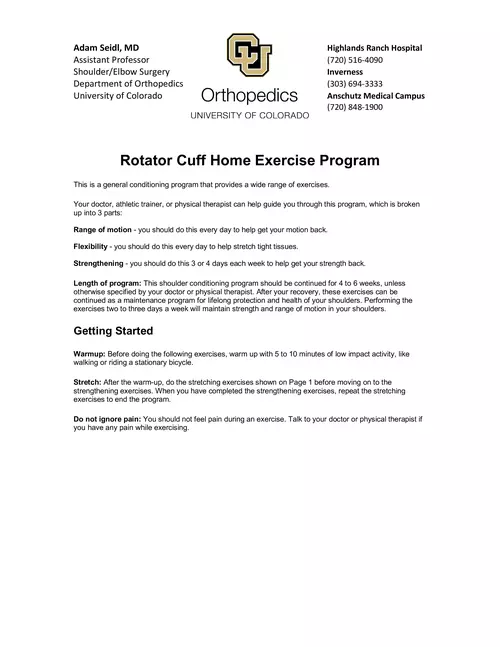
Rotator Cuff Home Exercise Program - Adam Seidl, MD
Rotator cuff and scapular strengthening. ? Correction of postural imbalances. ? Hints o. While performing exercises, keep shoulder rolled back and down.
adsPart of the document
Adam Seidl, MD Highlands Ranch Hospital
Assistant Professor (720) 516-4090
Shoulder/Elbow Surgery Inverness
Department of Orthopedics (303) 694-3333
University of Colorado Anschutz Medical Campus
(720) 848-1900
Rotator Cuff Home Exercise Program
This is a general conditioning program that provides a wide range of exercises.
Your doctor, athletic trainer, or physical therapist can help guide you through this program, which is broken
up into 3 parts:
Range of motion - you should do this every day to help get your motion back.
Flexibility - you should do this every day to help stretch tight tissues.
Strengthening - you should do this 3 or 4 days each week to help get your strength back.
Length of program: This shoulder conditioning program should be continued for 4 to 6 weeks, unless
otherwise specified by your doctor or physical therapist. After your recovery, these exercises can be
continued as a maintenance program for lifelong protection and health of your shoulders. Performing the
exercises two to three days a week will maintain strength and range of motion in your shoulders.
Getting Started
Warmup: Before doing the following exercises, warm up with 5 to 10 minutes of low impact activity, like
walking or riding a stationary bicycle.
Stretch: After the warm-up, do the stretching exercises shown on Page 1 before moving on to the
strengthening exercises. When you have completed the strengthening exercises, repeat the stretching
exercises to end the program.
Do not ignore pain: You should not feel pain during an exercise. Talk to your doctor or physical therapist if
you have any pain while exercising.
1. Pendulum
Main muscles worked: Deltoids, supraspinatus, infraspinatus,
subscapularis
Equipment needed: None
Repetitions: 2 sets of 10
Days Per Week: 5 to 6
Step-by-step directions
• Lean forward and place one hand on a counter or table for
support. Let your other arm hang freely at your side.
• Gently swing your arm forward and back. Repeat the
exercise moving your arm side-to-side, and repeat again in a
circular motion.
• Repeat the entire sequence with the other arm.
Tip: Do not round your back or lock your knees.
2. Crossover Arm Stretch
Main muscles worked: Posterior deltoid
You should feel this stretch at the back of your shoulder
Equipment needed: None
Repetitions: 4 each side
Days Per Week: 5 to 6
Step-by-step directions
• Relax your shoulders and gently pull one arm across your
chest as far as possible, holding at your upper arm.
• Hold the stretch for 30 seconds and then relax for 30
seconds.
• Repeat with the other arm.
Tip: Do not pull or put pressure on your elbow.
3. Passive Internal Rotation
Main muscles worked: Subscapularis
You should feel this stretch at the front of your shoulder
Equipment needed: Light stick, such as a yardstick
Repetitions: 4 each side
Days Per Week: 5 to 6
Step-by-step directions
• Hold a stick behind your back with one hand, and lightly
grasp the other end of the stick with your other hand.
• Pull the stick horizontally as shown so that your shoulder is
passively stretched to the point of feeling a pull without pain.
• Hold for 30 seconds and then relax for 30 seconds.
• Repeat on the other side.
Tip: Do not lean over or twist to side while pulling the stick.
4. Passive External Rotation
Main muscles worked: Infraspinatus, teres minor
You should feel this stretch in the back of your shoulder
Equipment needed: Light stick, such as a yardstick
Repetitions: 4 each side
Days Per Week: 5 to 6
Step-by-step directions
• Grasp the stick with one hand and cup the other end of the
stick with the other hand.
• Keep the elbow of the shoulder you are stretching against
the side of your body and push the stick horizontally as
shown to the point of feeling a pull without pain.
• Hold for 30 seconds and then relax for 30 seconds.
• Repeat on the other side.
Tip: Keep your hips facing forward and do not twist.
5. Sleeper Stretch
Main muscles worked: Infraspinatus, teres minor
You should feel this stretch in your outer upper back, behind your
shoulder
Equipment needed: None
Repetitions: 4 reps, 3x a day
Days Per Week: Daily
Step-by-step directions
• Lie on your side on a firm, flat surface with the affected
shoulder under you and your arm bent, as shown. You can
place your head on a pillow for comfort, if needed.
• Use your unaffected arm to push your other arm down. Stop
pressing down when you feel a stretch in the back of your
affected shoulder.
• Hold this position for 30 seconds, then relax your arm for 30
seconds.
Tip: Do not bend your wrist or press down on your wrist.
6. Standing Row
Main muscles worked: Middle and lower trapezius
You should feel this exercise at the back of your shoulder and into
your upper back
Equipment needed: Use an elastic stretch band of comfortable
resistance. As the exercise becomes easier to perform, progress to 3
sets of 12 repetitions. If you have access to a fitness center, this
exercise can also be performed on a weight machine. A fitness
assistant at your gym can instruct you on how to use the machines
safely.
Repetitions: 3 sets of 8
Days Per Week: 3
Step-by-step directions
• Make a 3-foot-long loop with the elastic band and tie the
ends together. Attach the loop to a doorknob or other stable
object.
• Stand holding the band with your elbow bent and at your
side, as shown in the start position.
• Keep your arm close to your side and slowly pull your elbow
straight back.
• Slowly return to the start position and repeat.
Tip: Squeeze your shoulder blades together as you pull.


